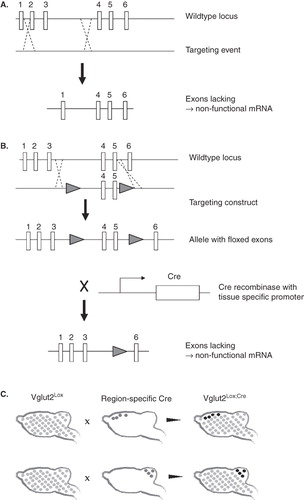Figures & data
Figure 1. In situ hybridization for Vglut2 on free-floating coronal adult mouse brain sections showing the expression pattern at three different bregma levels. Vglut2 mRNA is detected by blue labelling and is seen in the piriform cortex in A (bregma 1.34 mm); in the thalamus, hypothalamus, piriform cortex, and retrosplenial group of the medial cortex in B (bregma −1.46 mm); and in many cell groups in the brain-stem, including the geniculate and mammillary nuclei in C (bregma −3.28 mm).

Figure 2. A: Full knockout models can be generated by homologous recombination between the wild-type allele and a targeting construct. The targeting construct lacks one or more exons of the gene, usually in combination with some selection sites. The result after homologous recombination is an allele lacking one or more exons, and which will produce a non-functional mRNA. B: Conditional knockouts are made in several steps, where first a targeting construct containing one LoxP site on each side of the exons to be deleted is combined with the wild-type locus through homologous recombination. Second, when mice carrying the allele with ‘floxed’ (i.e. flanked by LoxP sites) exons are crossed with mice expressing the Cre recombinase, the floxed exons are deleted resulting in a gene producing non-functional mRNA. C: Depending on which promoter that drives the Cre expression, the floxed gene—in this case Vglut2—can be deleted in specific tissues only. As schematically illustrated here, Vglut2lox mice (floxed Vglut2 in all cells is illustrated with bright grey dots) mated with Cre mice, where Cre is driven by forebrain or cerebellum-specific promoters (dark grey dots in upper and lower panels, respectively) will result in different conditional knockout mice where Vglut2 expression is specifically deleted in the Cre-expressing regions (illustrated by black dots).

Table I. A summary of the different Vglut2 inactivation events, the cell population they affect and the phenotypes they give rise to.